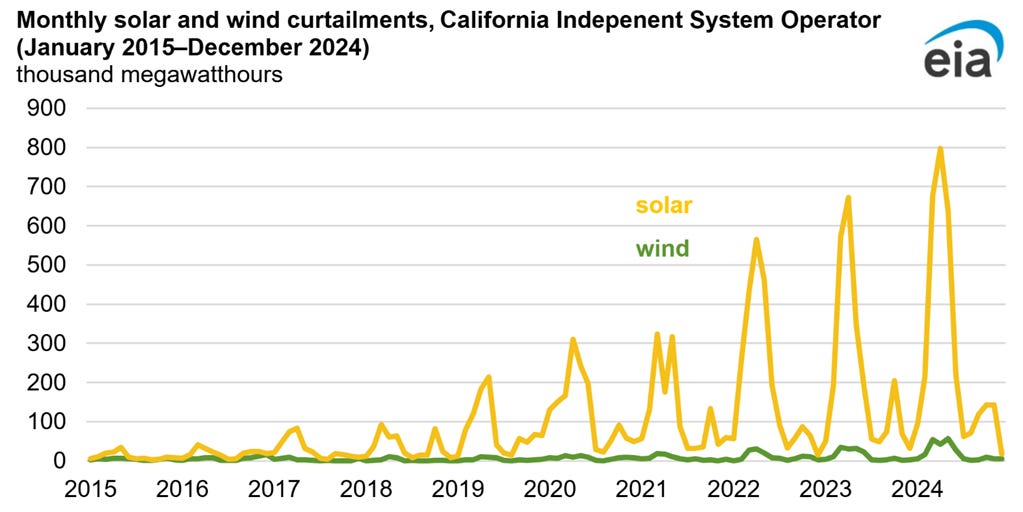California is throwing away solar power it can’t use
And stay tuned to American Experiment for my latest report.
It’s another beautiful Monday, but I would’ve given my right arm to be at the Alaska Sustainable Development Conference in Anchorage last week, where Secretaries Burgum and Wright, and EPA Administrator Zeldin, appeared together at a panel. It sounds like it was standing room only. I wrote about their consequential announcement for the National Petroleum Reserve-Alaska for IWF.
I also wrote about two more Minnesota issues: Talon Metals announced a site for processing nickel from its proposed Tamarack mine, about 475 miles away in North Dakota. Minnesota’s lawmakers also look set to retain wasteful e-bike rebates but cut the maximum rebate in half and reserve them entirely for low-income residents. Why should government be funding this, again?
Lastly, watch www.americanexperiment.org/reports for a new research paper from me.
California is throwing away solar power it can’t use
The Energy Information Administration (EIA) released a piece last week about the frontrunner in the headlong rush for more solar and wind power, California. The unfortunate result is that the state has so much solar generation at peak hours that the grid operator must curtail 29 percent more electricity than it did in 2023.
Curtailment is an involuntary reduction of generator output to maintain grid stability. An oversupply of electricity flowing into the grid disrupts its careful balance and can be disastrous.
Hence why the California Independent System Operator (CAISO) had to curtail 3.4 million MWh of utility-scale wind and solar output in 2024. The EIA reports:
Solar accounted for 93% of all the energy curtailed in CAISO in 2024. CAISO curtailed the most solar in the spring, when solar output was relatively high and electricity demand was relatively low, because moderate spring temperatures meant less demand for space heating or air conditioning.
In 2014, a combined 9.7 gigawatts (GW) of wind and solar photovoltaic capacity had been built in California. By the end of 2024, that number had grown to 28.2 GW.
The EIA also notes that CAISO must curtail solar to make room for natural gas, which because “a certain amount of natural gas generation must stay online throughout the day to comply with North American Electric Reliability Corporation (NERC) reliability standards and to have generation online in time to ramp up in the evening hours.”
To digress, the first concern for CAISO ought about the physics of the grid — that natural gas needs to be online for the evening and nighttime when solar generation predictably fails — not that some grid monitor has rules about it. NERC has certain grid reliability rules because of the physics.
The EIA again:
Solar energy supplies almost half of CAISO’s electricity demand between the hours of 8:00 a.m. and 4:00 p.m., but demand increases in the later evening hours when people come home from work and turn up air conditioners or electric heaters and turn on lights, ovens, computers, and televisions. This need is especially apparent on hot summer evenings after the sun has set and no longer produces solar power overnight.
CAISO is trying to reduce curtailments in several ways:
Trading with neighboring balancing authorities to try to sell excess solar and wind power
Incorporating battery storage into ancillary services, energy, and capacity markets
Including curtailment reduction in transmission planning
In addition, starting this year, companies are planning to use excess renewable energy to make hydrogen, some of which will be stored and mixed with natural gas for summer generation at the Intermountain Power Project’s new facility scheduled to come online in July.
Translation: in the short term, California wants to export more of its wind and solar excess to neighboring states, likely at a negative price, which will in turn make neighboring gas and coal plants less efficient despite their necessary reliability attributes. In the long term, it wants to use more battery storage, which has enormous challenges, and build more transmission lines to send solar generation farther afield, which will cost billions of dollars that would not be necessary were it not for overbuilding.
Look at the curtailments soar as the penetration of wind and solar into California’s grid increases:
It should be no surprise that in March 2025, California clocked the second-highest average residential electricity price of 32.41 cents per kilowatthour, behind only the island state of Hawaii. Minnesota already has the highest residential price in the Census Bureau’s West North Central region, at 15.12 cents per kWh.
How high will it have to go before Minnesota’s policymakers get serious about avoiding California’s fate and prioritizing grid reliability and affordability?
This piece was originally published at Center of the American Experiment on June 4, 2025.







A very nice summary, ma'am. Thank you.
Doomberg has said "in the battle of platitudes vs. physics, physics is undefeated." California's plight is the poster child for this axiom. Your conclusion asks, "How high will it have to go before Minnesota’s [or any state, for that matter] policymakers get serious about avoiding California’s fate and prioritizing grid reliability and affordability?"
So long as we allow energy policy to be subjected to the four-year political cycle, there is indeed no limit to high for lawmakers whose sights are set on virtue signaling and not grid reliability or affordability.
A rigorous planning process would have identified these issues and scheduled construction activities to minimize them. However, planning was bypassed in favor of aggressive goal setting driven by politics rather than moderated by physics.
"A failure to plan is a plan to fail.", Benjamin Franklin